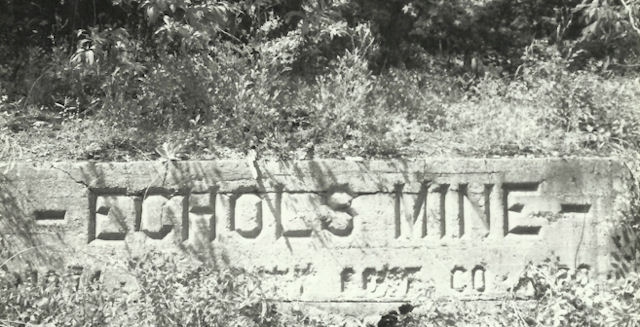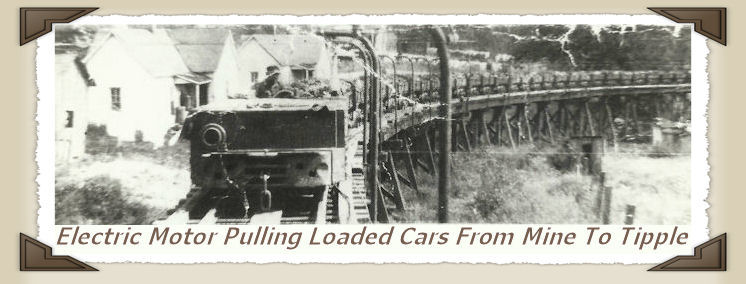 |
| ECHOLS MINE. |
 |
 |
|
McHenry Coal Company-Echols Mine.
11/12/13 by jrd. Pictures used on this web page are from various places including Shirley Smith. The text is from memories gathered from my family and others as well as from "History Of Rockport And Echols", a book by Shirley Smith. Thanks Shirley. Airdrie Hill is located in Muhlenberg County, less than a mile downriver from the old town of Paradise. As the crow flies, this famous old hill is not far from Echols. In the middle of the nineteenth century, a Kentuckian of Scottish descent, had a dream of producing good quality iron from the area and transporting the product downriver on the Green River. He persuaded some two hundred men, mostly immigrants from Scotland to work for him in building an iron ore smelter, including an equipment room. This endeavor included opening an iron ore mine as well as a coal mine to produce coal for the smelter. A lot of these Scottish immigrants were from a place in Scotland called Airdrie and thus, this construction site was named Airdrie. The experienced immigrants included stone masons, miners, carpenters, smelters, laborers, and other craftsmen required to build this modern iron ore foundry. In 1850, initial purchase of the land and the construction phase of the project was started. It was finished some two years later and for several months the start up phase failed. Problems with the smelting process and the hardheadedness of a Scotchman, unwilling to try other methods, spelled doom for this new adventure. The furnace failed on the first few attempts and in 1857 the foundry was shut down. The two hundred or so Scottish workers were now without a job and an income. Most were miners and they scattered out in Ohio, Muhlenberg and other surrounding counties. Their work ethics enabled them to become successful coal miners. A lot of the miners became natives of Rockport, Echols and McHenry. Including in this group of miners, now without a job, was David Duncan. He and his family opened a mine in Aberdeen and after a few years of operation sold out and became partners with Henry McHenry in establishing the "McHenry Coal Company". The McHenry Coal company opened the McHenry Mine and a short time later purchased the Echols Mine. John Echols probably opened the Echols Mine in the 1875 time frame. Shirley Smith's book, "History Of Rockport And Echols" states that the first commercial mine in Ohio County was the Render Mine, followed by the McHenry Mine and then the Echols Mine. The first commercial shipment of coal from the Echols Mine was in 1875. Guess, like most of us "Seniors" that were born in the thirties, forties and fifties, we can remember tales and stories about mines in the Rockport, Echols, and McHenry area. Thus, the Render Mine, the Echols Mine, and the Rockport Mine were and still are a memory etched in our minds. Each can probably visualize how we thought the mine would look, as until recently, I had not seen many mine pictures of this era. I do remember that "Buck" Curtis opened and ran a mine on the Rockport side of "Graveyard" hill between Rockport and McHenry. This mine would "Run" at irregular intervals, sometimes working a day or two a week. The output coal was trucked out using a small tipple and the total number of miners would consist of less than a dozen men. Guess this is what I envisioned for the Rockport and Echols mine. How wrong I was! The Echols mine was in operation from 1875 until 1940 and at times employed some 200 miners. The tipple pictured below is enormous as compared to some of the smaller "Truck" mines that operated in the area in the middle part of the twentieth century. Some thirty-five years after the Echols Mine started producing coal, it was purchased by the Louisville Gas and Electric Company. Coal continued to be mined for another thirty years until it closed in 1940. Louisville Gas and Electric Company, after closing the Echols Mine, transferred the Echols miners to a newly opened mine, "Cherry Hill Mine", located in Muhlenberg County. Pictures of the Cherry Hill miners, in the late forties, consisted of miners mostly from the Rockport/Echols area. As mentioned earlier, as the crow flies, the distance from Echols to the Green River, or to Rockport is about two miles. My grandfather Russell worked in the Echols Mine and lived at Rockport. His family was part of the many craftsmen that immigrated from Scotland to construct the Airdrie Hill Iron Ore Foundry. Other miners from Rockport worked the Echols Mine. For less than a dollar a day, my grandfather and other Rockport miners walked the two miles to the Echols mine, worked their eight or so hour shift, and walked back to Rockport. Sometimes they would stop by the company store on the way home and pick up a few groceries or other needed items. Bacon was twenty-five cents a pound, thus they worked two hours to pay for a pound of bacon. As he and other miners were walking to the Echols Mine, they would meet some of the Echols youngsters that were walking to Rockport to attend school. They would meet again, along the railroad tracks on their respective way back home. Echols was a shaft mine, unlike the slope mines of Render and McHenry mines. Access to the coal was by a vertical lift extending down a little less than a hundred feet. Coal was transported in the mine on small trams or cars being pulled by small donkeys and was taken to the tipple in like manner. Later, in the early part of the twentieth century, electric motors were used instead of the donkeys. These coal cars were small by today's standards and held less than 200 pounds of coal. In the earlier years of the Echols mine, the miners were able to "Load Out" six cars of coal a day. Soon this was increased to twenty cars a day. Afterwards, forty cars a day were considered the norm. An air shaft, using a large furnace inside the mine to circulate the air for mine ventilation, was located on the Southeast side of Echols and on the hill toward Scottown from Echols. Fuel for the furnace was coal from the mine. In later years, this fresh air supply for the mine and miners would be by fans using electric motors. The railroad headed almost due East from Rockport toward Echols, and veered Northeast at the edge of Echols, near the old Company Store and the tipple. It continued Northeast going through a tunnel and on to Louisville. In general, Echols was East of the tunnel and "Punkin Ridge" was toward Rockport or West. In the area where the railroad curves to the Northeast is where the company store and the tipple were located, as well as the "Railroad Crossing". This is also the area where the Western Kentucky Parkway was built. The Western Kentucky Parkway crosses the Green River at the high bluff called Jackson Hill or Jackson Bluff. As youngsters, we called it Graveyard Hill, sometimes referred to as "Indian Graveyard Hill". In earlier years, Indians must have used this hill as a "Day Camp" or other purpose as we would find plenty of mussel shells and some arrowheads as we played on the hill. The parkway was built over the area where parts of "Old Echols" was located. The mines and the company store were located on the South side of the railroad and in the general area of the parkway. The tipple was located on the North side of the main railroad. The coal being mined was loaded on trams or small railway cars with the tram tracks crossing over the main railroad tracks for delivery to the tipple. From the tipple, the coal was loaded on the main railroad for shipment to the buyers. The Echols General Baptist Church was moved from the original location, near Scottown, to its' present location on Echols Church Lane. This lane, off Hwy. 1245, heads to the West and downhill to the area where the Company Store and the tipple were located. It crosses the railroad and at one time headed back North and connected back with Hwy. 1245 near where John Boone had his general store. I don't think this road is completely accessible today. This old crossing has seen some busy times. It was the ending point, in the mornings, for the miners walking to work from Rockport and the starting for the students walking to school at Rockport. This was reversed in the afternoons. What was then is no more and the memories of that old crossing are becoming nonexistent. Actually, I have written a little more than I know. As usual, I challenge anyone with any knowledge of the Echols Mine to correct any mistakes they see and/or to add any information to this web page. I even have less knowledge of the Rockport Mine and no pictures. Again, I would appreciate any help here and if I can gather any material, I will come up with a web page for the Rockport Mine. Thanks for looking and hope the trip was worthwhile. See you... jerry ; ~ ) |
|
|
jerry durham |